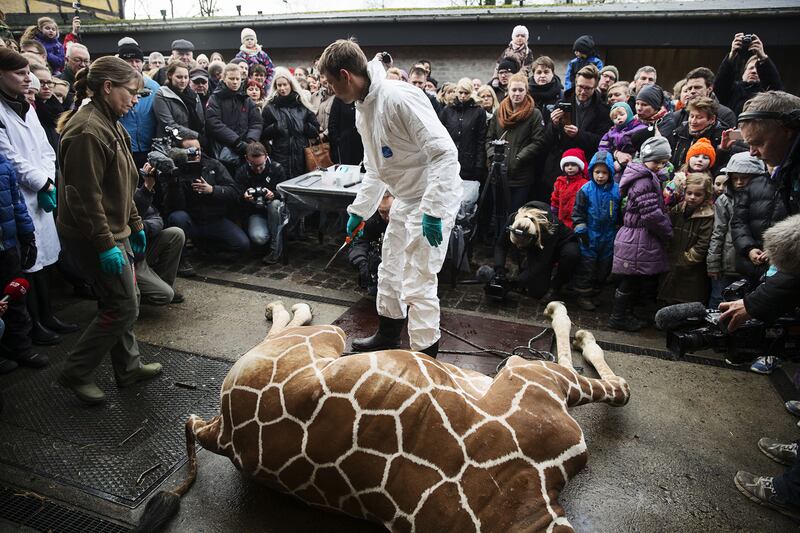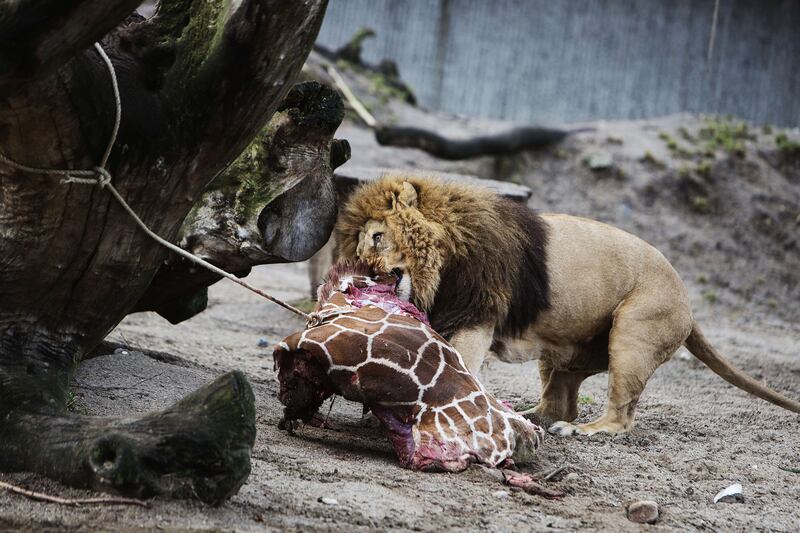You’d think killing a giraffe would be enough. Never mind that the giraffe was perfectly healthy, or that its killers worked at the Copenhagen Zoo—which, as a rule, much prefers its giraffes alive than dead—or that they killed it in front of a group of children, or that the children watched the giraffe be dismembered and fed to the zoo’s lions (teachable moment?)—or that when word got out, the zoo received the condemnation of animal lovers everywhere.

You’d think the zookeepers would learn their lesson. You wouldn’t think that, a month later, they’d kill four healthy lions.
Were they the same lions to whom they had fed the giraffe? I don’t know. I stopped reading. But I bet even Dr. Moreau is on his island somewhere thinking, those Danes are nuts.
Their excuse for the killing the giraffe was that they were worried about inbreeding. OK, maybe, I guess. Still seems excessive. Their excuse for striking again? They claimed they had to kill the four lions this week to make way for…one lion. There was a single new male lion due to show up in their neck of the fake woods, a newly crowned king of the fabricated jungle, who would, they insisted, most definitely possibly maybe have eaten two young lions who were not able to survive on their own.
Now, you might reasonably be wondering: Why did the cubs have to survive on their own? What, did the zoo kill their parents as well?
Yes, yes they did.
And why did they do that? Wherefore Mufasa and Sarabi? The official zoo line is that the parents’ advanced age made them unable to protect their youngsters. So to recap: You know those two lions that were frisky enough to have lion sex and give birth to lions? They’re too frail to stand up for themselves. So we have to put them down. And now that their defenseless cubs are orphaned…
At least the Danish zookeepers were consistent. Those four lions were clearly too young. And too old.
As the zoo saw it, there was new blood, and they didn’t mind spilling some old (and young) blood to make room. Think of it as the horror version of The Lion King. The circle of yuck.
The zoo’s scientific director, Bengt Holst, was shocked that the world was so shocked over the killing of the giraffe. “I do not understand the outrage,” he said. “We are all used to on a current basis of animals being culled in the wild.”
Yep, in the wild. And if there’s anything we know about the average zoo, it’s that it perfectly reflects the wild in every respect. But look: I can’t argue the theory. I understand that sometimes undergrowth has to be cleared to ensure that the healthiest trees grow big and strong. Thin the herd, and all that. But in this case, the best defense is a deeply offensive offense.
They killed a giraffe. In front of a group of kids. Then fed it to some lions. (The giraffe, not the group of kids. Although the fact that I’m compelled to make that distinction is saying something.) Then they killed four lions.
A spokesman, Tobias Stenbaek Bro, insisted the zoo tried to place the two young cubs elsewhere, but “unfortunately there wasn’t any interest.” Sign #1 that you are a terrible zoo? You can’t make baby lions interesting. Not even to other zoos.

Signs #2 through infinity? If you can’t relocate your animals, your next best plan is to kill them. I would have thought build a wall might have come up. Surely a wall was an option. There had to be an IKEA nearby.
It’s astonishing to believe they didn’t consider other options. After all, as the German philosopher Schopenhauer said, “hakuna matata.” Or to translate: “It may be confidently asserted that he who is cruel to animals cannot be a good man.” That’s why the Copenhagen Zoo, which for all I know is an amazing zoo, is a terrible zoo.
I haven’t been there, but I’ll wager it’s not Jurassic Park. I suspect there aren’t packs of T-rexes running amok that must be taken down before they jump the electrified perimeter and swim to Costa Rica. If that were the case, I’d expect a little collateral damage.
And I recognize that Americans have our own uneasy relationship with human executions. This week was certainly no exception. But whether or not you believe in capital punishment, you can’t help but notice that those who are executed have at least been convicted of a crime. What crimes did the giraffe and lions commit? The verdict’s out.
But every species should wonder: just how is it possible that a group of people so committed to protecting and celebrating some of most captivating creatures on earth can also be so flippant about killing them?
Humans. They can be animals.





